History Features
Brief History of Keble College
This webpage will provide a brief overview of the history of Keble College, with links to further information. Details about visiting the College can be found at https://www.keble.ox.ac.uk/visiting-keble/.
John Keble
Oxford colleges are often named after either a benefactor or a saint. John Keble was neither of these things; however, his influence on the religious and cultural life of Oxford and indeed Britain meant that such a memorial was justified.
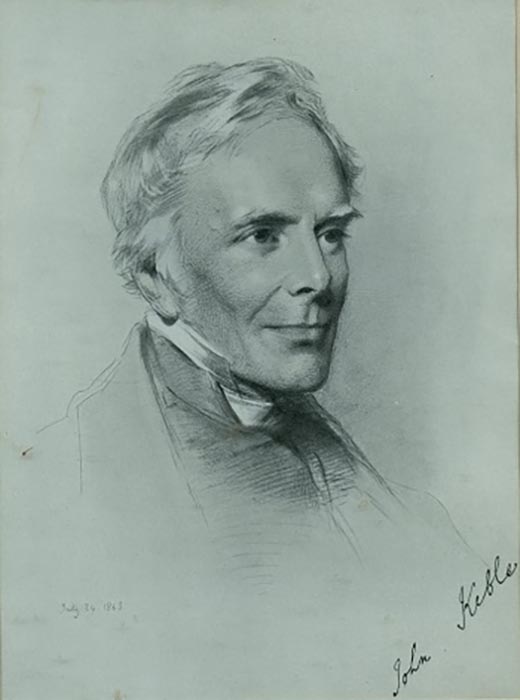
An autographed copy of an engraving of a young
John Keble by George Richmond
Along with John Henry Newman and Edward Bouverie Pusey, John Keble was a key figure in the Oxford Movement — known as the Tractarians, this Anglican group focussed on issues like the renewal of certain Catholic doctrine in the Church of England, forms of service, and the relationship between the state and the Church. Newman and others have said that John Keble’s assize sermon “National Apostasy”, preached in the Church of St Mary the Virgin, Oxford on 14 July 1833, can in fact be considered the start of the Oxford Movement.
Having excelled as a Scholar of Corpus Christi College, Oxford, where he gained a Double First in Classics and Mathematics, John Keble was quickly elected a Fellow at Oriel College, where he became Tutor. Later ordained, he became curate of Hursley in Hampshire. Keble’s collection of devotionial verses, The Christian Year, was published in 1827 and proved remarkably popular, leading to his election as Professor of Poetry at Oxford in 1831.
Keble died on 29 March 1866.
➤For more information about John Keble, please visit https://heritage.keble.ox.ac.uk/history-features/john-keble/.
Foundation of the College
John Keble’s death coincided with a renewed focus on the idea of ‘University Extension’, with the aim of making Oxford more accessible for ‘gentlemen wishing to live economically’ – an early attempt to broaden the social depth of the student body. Though not directly involved in those discussions, Keble had been supportive of them. When Keble died, a group of Tractarians, including Pusey and Henry Parry Liddon, met to discuss a fitting memorial for him. They resolved to establish a new college in Keble’s name, which would have a strong Anglican ethos, and would provide a more economical alternative to traditional Oxford colleges. This new approach would be evident in the very fabric of the College, with student rooms arranged along communal corridors rather than staircases, and furnished by the College, rather than students themselves. Furthermore, Hall was designed to be large enough to accommodate all students in order to discourage private dining and entertaining, which was the usual practice elsewhere.
Lacking any form of endowment, a committee was quickly set-up to seek donations towards the establishment of the College, making Keble the first college to be built through public subscription rather than individual or institutional wealth. With donors possibly being motivated by the popularity of The Christian Year, sympathy with the Tractarians and approval of the proposed college’s goals, the committee received many subscriptions, large and small. Within two years, sufficient funds had been raised to allow the purchase of land from St John’s College and the start of the building work, with architect William Butterfield being key in the selection of the site, as well as the design of the earliest of the College’s now iconic buildings.
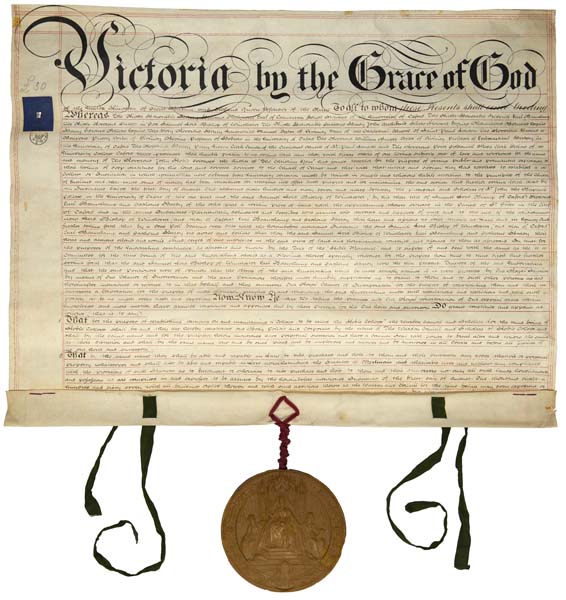
The first page of Keble’s Charter of Incorporation
➤A more detailed account of the foundation of Keble College can be found at https://heritage.keble.ox.ac.uk/history-features/foundation-of-college/.
Statutes and Status
When Keble College was founded, there was much dispute about the status it should have in relation to the University. In the end, it was incorporated into the University by means of a new statute of Convocation – “On New Foundations for Academical Study and Education” – on 18th April 1871. This gave Keble College the status of a New Foundation, rather than allowing the privileges of full membership of the University until the granting of new statutes in 1952.
Keble College started admitting women in 1979, at both senior and junior levels. Keble was the first previously all male college to appoint a female Warden, when it appointed Averil Cameron as the eleventh Warden in 1994.
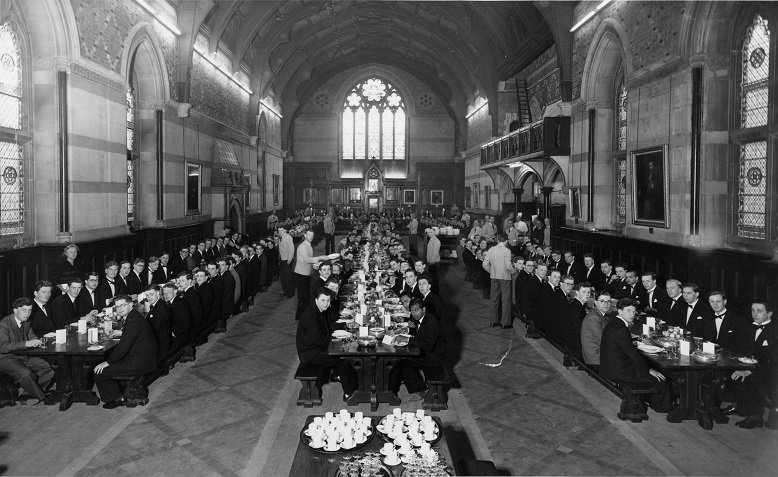
Black and white photograph of a dinner in Hall
to celebrate the College gaining full status
➤For further details of the College’s statutes, see https://heritage.keble.ox.ac.uk/history-features/foundation-of-college/.
Architecture
Butterfield buildings
The first thing many people think of when they think of Keble College is the distinctive polychromatic brickwork of its earliest buildings. Controversial at the time but now much loved, these buildings are a fine example of Victorian Gothic architecture, designed by William Butterfield. He was sympathetic to the Tractarians and had worked for John Keble at Hursley. Butterfield’s most famous works before Keble College include the visually striking church of All Saints, St Margaret Street, London. He also created the Chapel at Balliol College. Around the time Keble College was built, he also designed buildings at Rugby School, using the same builders as he used at Keble College (Parnell and Son of Rugby).
The way in which funds for the College were raised had inevitable consequences for the building works, requiring a phased approach. There was a temporary Chapel and Hall on the site of the current Library and Hall. Work started with the accommodation blocks on the Liddon quad, then the ‘Servants’ building (now the Clocktower). Then work started on the East side of the Pusey quad and the Chapel. The Hall and Library followed, along with the Warden’s Lodgings. The final piece of Butterfield’s design to be erected was the West side of Pusey quad. The work on the Chapel was made possible by the benefaction of William Gibbs (a businessman, famous for importing guano from Peru); however, he died shortly before it was completed. His sons, Antony and Martin Gibbs provided the funds to build the Hall and Library.
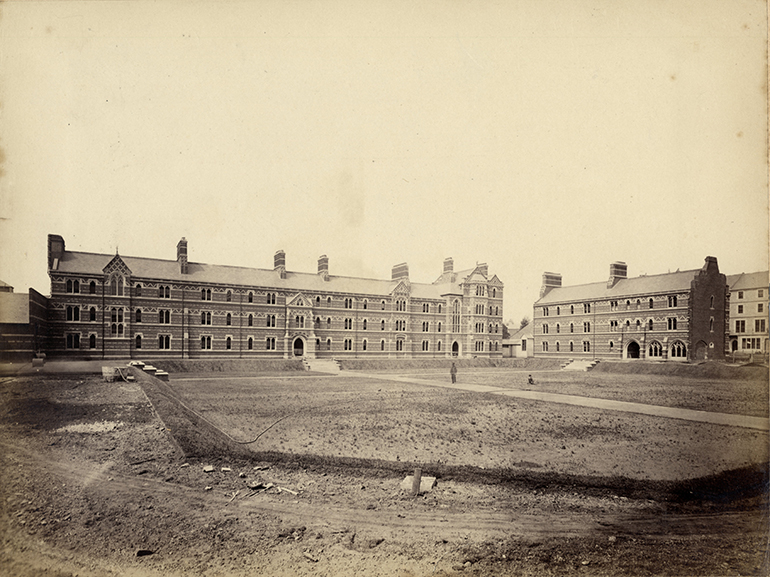
Black and white photograph of the west and north ranges of
Liddon Quadrangle, Keble College, before the Chapel was built
Butterfield’s buildings at Keble College are Grade I listed.
Hayward and De Breyne buildings
The 1970s saw significant expansion, with a Centenary Fund raising enough for new buildings by the architects Ahrends, Burton and Koralek (ABK). The De Breyne quad (completed in 1972) was largely funded by the Adeby Trust (Andre De Breyne). The second phase (completed in 1976) was primarily funded by the Hayward Foundation (Sir Charles Hayward). The Hayward and De Breyne buildings are both Grade II* listed. From the outside of the College, they carry on the Keble tradition of using brick; however, when viewed from the quad, they are notable for the extensive use of glass.
Sloane Robinson and ARCO buildings
As demand for in-College accommodation rose, the Fellows’ Garden was developed into what is now Newman Quad. This dramatically sunken quad houses the ARCO building (begun in 1993), which provides both study bedrooms and seminar rooms, and the Sloane Robinson building (begun in 2001), which includes the O’Reilly theatre and the large Douglas Price meeting room. Both buildings were designed by the architect Rick Mather, whose work includes the 2009 Ashmolean Museum six-story expansion, as well as recent developments at Corpus Christi, Queen’s and Mansfield colleges.
HB Allen Centre
In 2004, Keble College bought the Acland Hospital, on the opposite side of Banbury Road to the pre-existing College buildings. Having received funding from the H B Allen Charitable Trust and others, construction of the HB Allen Centre started in 2015. Designed by Rick Mather Associates (now MICA), this site provides accommodation for postgraduates, seminar rooms, a lecture theatre, a café and space for commercial tenants, supporting inter-disciplinary research and spin-out activities at the the University. Although most of the Acland Hospital was demolished, Sarah Acland House (designed by Thomas Jackson, Grade II listed) was retained. A large basement, underneath most of the site, posed the engineering challenge of how to excavate underneath the existing building.
It was opened by HRH The Duke of Cambridge in 2019.
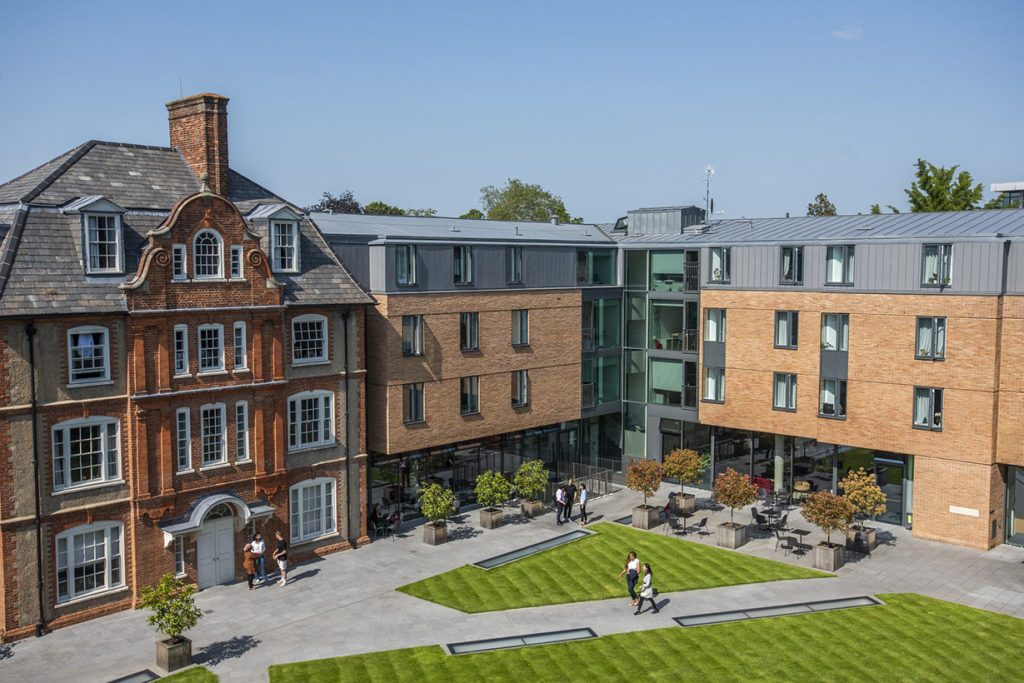
The H B Allen Centre provides a home for a growing graduate student community
➤A more detailed account of the architecture of Keble College can be found at https://heritage.keble.ox.ac.uk/history-features/architecture/.
➤For details of the construction and opening of the College, including information about the Gibbs family, please see https://heritage.keble.ox.ac.uk/history-features/opening-of-college/.
The Chapel and Light of the World
Visitors to the Chapel enter at the West end, usually passing a First World War memorial (designed by F C Eden) on their way. Upon entering, they will see windows and mosaics by Alexander Gibbs, who Butterfield, the Chapel’s architect, had sent to Venice to study the mosaics there. The Chapel mosaics depict scenes from the Old and New Testaments. Above the altar is a large quatrefoil mosaic depicting Christ in Majesty. Liddon had wanted a Crucifixion image but following much debate, Butterfield’s choice of subject was accepted.

The Keble Chapel, designed by William Butterfield
Butterfield decided that the Chapel should be arranged like a parish church, with the seating facing the altar. In many other colleges, the Chapels are arranged with seating along the sides, facing inwards.

The Light of the World by William Holman Hunt, 1853
A further dispute surrounded the Light of the World, which Butterfield and William Gibbs felt should not be hung in the Chapel. Painted by William Holman Hunt and completed in 1853, it was offered to Keble College by Martha Combe in 1872, following the death of her husband, Thomas Combe (Printer to the University, Oxford University Press). The painting was accepted but a prolonged debate about where it should be hung meant it was not displayed in the College until 1878, when it was placed in the newly opened Library. Following the death of Liddon in 1890, the organ was raised in the Chapel transept, to create space for a Side Chapel, which could be used for services and also house the Light of the World. This work was carried out by J T Micklethwaite, after Butterfield refused to do it.
➤Further details about the Chapel can be found at https://www.keble.ox.ac.uk/about/chapel/, with a description of the Light of the World available at https://www.keble.ox.ac.uk/about/chapel/light-of-the-world/.
Library and Hall
Keble College’s Library and Hall were opened in 1878. The Library was originally for the use of Tutors only but was opened to all members of the College in 1920. It is now open twenty-four hours a day to College members. The ground floor reading rooms were opened in 1981. The Library’s collections comprise the working library and the Special Collections. The latter includes the personal library of John Keble, as well as 70 medieval manuscripts and a significant collection of early printed books, including several early editions of Dante’s Divine Comedy.
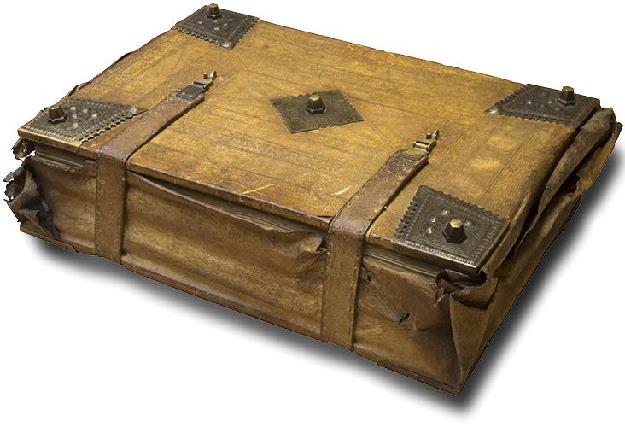
The richly illuminated Regensburg Lectionary forms part of the Special Collections
The Archives can also be found in the Library. These include records documenting the College’s history, as well as personal papers of people associated with the College. Highlights include Butterfield’s original drawings and the manuscripts of John Keble’s Christian Year poems.

The Manuscripts of the Christian Year by John Keble
Although the Library is not ordinarily open to the public, researchers may book appointments to see the Special Collections and Archives.
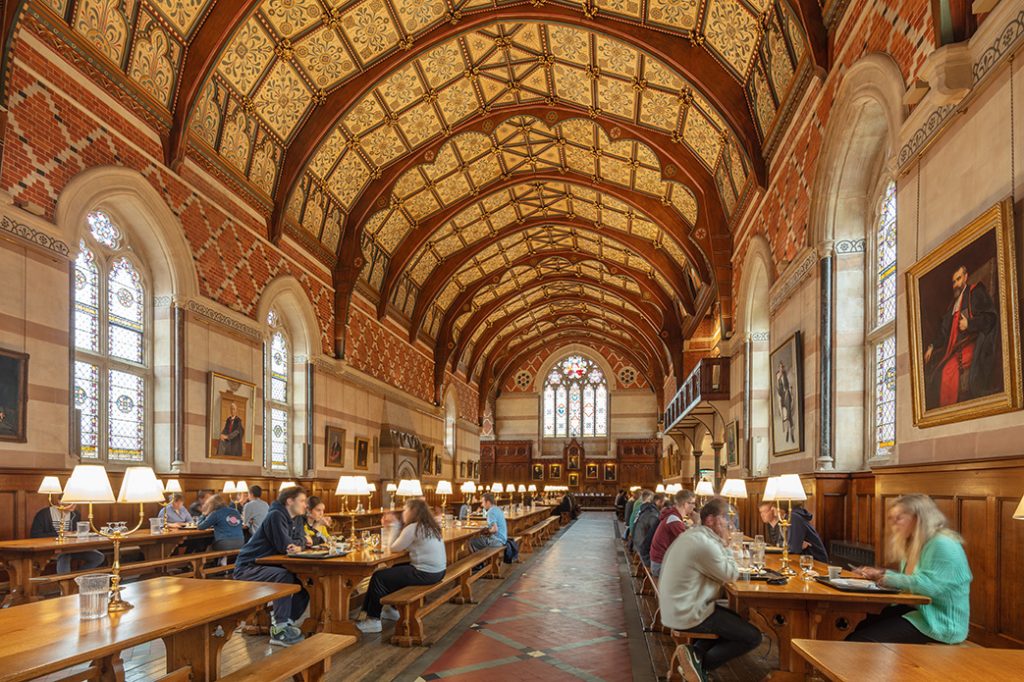
The Keble Dining Hall
The Hall is notable for its size, designed to be large enough for all members to dine in, at a time when such communal dining was much less common in Oxford colleges. The High Table can be found at the West end. Portraits of various members of the Oxford Movement, former Wardens and donors are hung on the walls.
Grounds and Gardens
One of the first things visitors to the College will notice is its sunken quads (see Opening of the College), which have the effect of emphasising the size of the buildings, not least the Chapel. There was once a Fellows’ garden in what is now the Newman quad but the expansion of the College necessitated building on part of that land. Now the grounds feature manicured lawns, striking borders and the magnolias in the Pusey quad.
The wrought iron gates which now separate the Liddon and Newman quads were built in 1960. A gift from Reverend Hiram K Douglas (Keble 1919), they are a memorial to the donor’s parents and Reverend Dr B J Kidd (Warden, 1920-1939 and feature the coats of arms of Keble and Douglas.
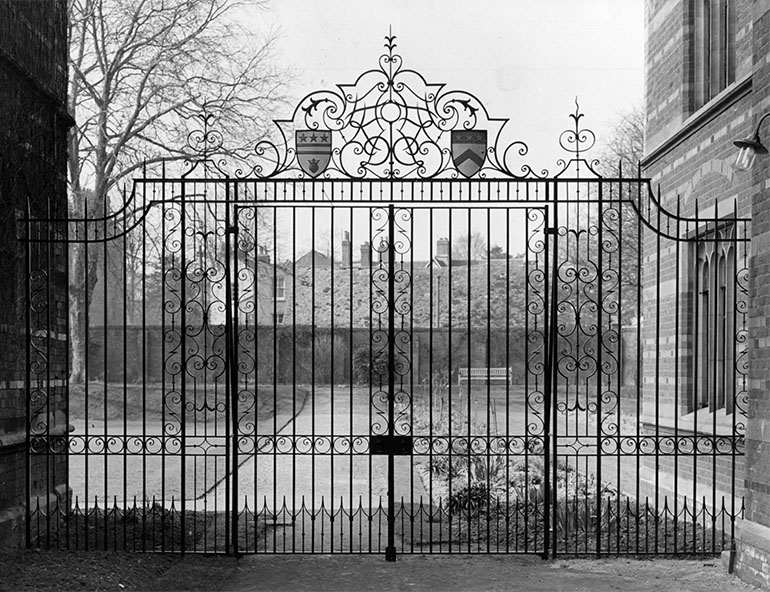
Photograph of the Douglass Memorial Gates, c.1960
➤For more details about the history of the gardens, please see https://heritage.keble.ox.ac.uk/history-features/gardens-and-grounds/.
➤For further details about the gate, please see https://heritage.keble.ox.ac.uk/history-features/forgotten-passages-and-doorways/.
Keble Today
Keble is one of the largest colleges in Oxford, with over 800 students, about half of whom are undergraduates, and around 50 Fellows, 50 lecturers and over 100 support staff. Education and advancing knowledge are at the heart of the College’s mission with research and learning taking place across a broad variety of subjects.
The College seeks to create an environment in which ideas can be freely debated and challenged by individuals with open minds who respect each other’s differing points of view. That is an important feature of our diverse community. We welcome students from all over the world. With the enthusiastic help of current students, the College is very active in trying to persuade people to come to this University who have not previously thought of doing so.
Our current Warden, appointed in 2022, is Dr Sir Michael Jacobs — an Infectious Diseases specialist and former Clinical Director of Infection at the Royal Free Hospital, where his team was at the centre of the UK response to the West Africa Ebola outbreak. In early 2020, the same team treated some of the first UK COVID-19 patients.
Back to Features